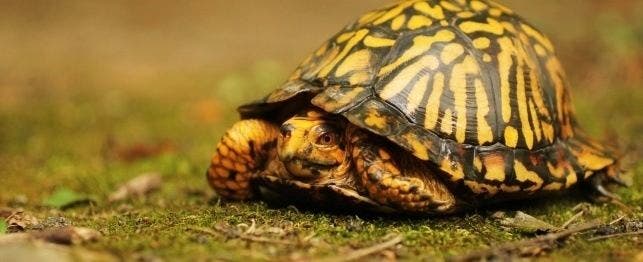
Choosing a Turtle
If any vertebrate on earth can be considered the winner in the evolutionary race it is the turtle, which has survived 250 million years nearly unchanged. They are indeed the ancient ones and if you decide to keep one as a pet it deserves some special respect. A well-cared-for turtle could certainly outlive you – many are known to have lived more than 100 years – so don’t take your responsibility lightly.
Turtles are reptiles, which means that unlike fish or amphibians that lay their eggs in the water, the leathery shell of a turtle egg encases a liquid-filled case, the amnion, in which the unborn develop. Like all reptiles they breathe air and have scales and a three-chambered heart.
They are also ectothermic animals, which means that their body temperatures depend upon the temperatures of the environments around them. In the wild they will bask in the sunlight in order to raise their temperature; in captivity they depend upon artificial light to provide them with the appropriate heat.
Some 250 Species of Turtles
Turtles live in most environments around the world. There are some 250 species. Many live in the oceans, migrating thousands of miles each year and coming up on land only to lay their eggs. Some, like snapping turtles, live in freshwater. The largest family, Emydidae, such as red-eared sliders, box turtles, and painted turtles, are semi-aquatic and come up onto land more often. And tortoises, the true land turtles with their thick elephantine legs, can survive in some very harsh terrestrial environments.
What distinguishes the turtles are, of course, their bony shells. The section that covers the turtle’s back is known as the carapace. The section under the belly is called the plastron. The bony welds that hold the shell together are known as bridges. The armorlike plates that cover the shell and give each turtle its distinctive design and color patterns are known as scutes or laminae. They are shed as the turtle grows. The turtle’s shell is extremely strong – a box turtle can support up to 200 times its weight.
Turtles are slow, but have extremely mobile necks due to a bunching of vertebrae close to the head. This enables them to reach for food as well as to pull their heads into their shells for protection. Although turtles are toothless, their jaws are sharp and made for tearing at meat such as worms, snails, and slugs. Many eat fish and most enjoy sweet fruits and in the summer can often be found under berry bushes. This location sense serves turtles well. They usually pick a few resting places in their containment area, returning to them each day.
The turtle’s needs may seem simple: a place to bask, fresh water, a varied diet, and proper temperature, but maintaining ideal conditions over the long run – which can be many years – requires a great deal of time and dedication.